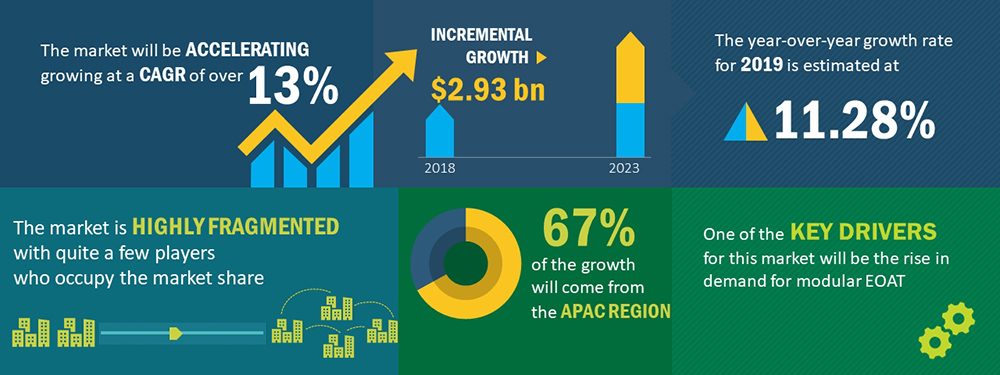
The Gripper Chronicles
Gripper Sales Double by 2023; Asia Accounts for 67%
OnRobot: “With the dawn of smarter, more adaptive tooling, robots can now function with greater speed, strength, safety and precision, accomplishing a wide range of tasks, helping manufacturers maximize ROI.”

 Editor’s Note: Day Two of Hannover Messe (2 April) could well be a very exciting day for OnRobot, the Danish maker of grippers (a/k/a end-of-arm tools). OnRobot’s Gecko Gripper is one of three finalists for the annual Hannover Messe Robotics Award (Prize: $10k, media bump, and bragging rights at Hannover Messe).
Editor’s Note: Day Two of Hannover Messe (2 April) could well be a very exciting day for OnRobot, the Danish maker of grippers (a/k/a end-of-arm tools). OnRobot’s Gecko Gripper is one of three finalists for the annual Hannover Messe Robotics Award (Prize: $10k, media bump, and bragging rights at Hannover Messe).
OnRobot is the 2018 marriage of technologies from Hungary’s OptoForce, US-based Precision Robotics, with Denmark’s Purple Robotics and OnRobot (the four operating under the OnRobot brand umbrella). OnRobot is out to be the “one-stop shop for robot accessories”.
OnRobot, another of the Odense-based robotics wunderkinder (in Danish: vidunderbørn) that have been storming through the robotics industry with stunning tech these last few years, is stretching its brand seemingly in every direction at once. Asia is in reach with OnRobot’s office in Singapore. Wise decision seeing that Asia-Pacific is due to purchase 67% of all grippers, helping the gripper industry to double in sales by 2023.
Niels O. S. Sørensen, General Manager, OnRobot APAC (Singapore) offers up his take on gripper tech, markets & sales for The Gripper Chronicles. Niels, welcome.

Diving into the Concept of Collaborative Applications
Smarter and more versatile robotic tools, or end-of-arm tooling (EOAT)—sensors, grippers and quick changers—empower robots to take over repetitive tasks, freeing them to handle adaptive, higher-precision and more intelligent applications that in the past were too complex to automate.
More importantly, these advanced tools enable collaborative applications that allow workers and robots to operate safely side by side due to the user-friendly nature, intuitive programming and safety features of EOAT-fitted robots.
Singapore and Southeast Asia
Singapore, and much of Southeast Asia, is enthusiastic about robots.
According to a recent report, Singapore is one of the global leaders in robotic adoption, with 658 installed per 10,000 workers, the second highest rate. Looking at the global rankings of expected robot adoption rates, Southeast Asian nations occupy six of the top seven positions.
Increased robotic adoption in emerging markets has fuelled the need to deploy advanced tooling features. These trends have helped increase EOAT adoption significantly. According to QYResearch, the global robotics EOAT market, valued at US$1,580 million in 2018, is expected to reach US$2,740 million by the end of 2025.
Editor's Note: Also see below Technavio’s chart
on the burgeoning gripper market, especially Asia.

Prioritizing EOAT Before the Robot
Due to technological advances, EOAT have become more sophisticated and capable. How robots are deployed and what accessories are fitted and utilized will become more integral than robots alone. In the past five years, robots have been used in a wider range of applications than ever before because end-effectors can now function better, and in more specific environments.
Apart from handling variations in product size, weight, and shape, EOAT also enables robots to accommodate several processes at once. With EOAT bringing these enhanced capabilities to robots and this trend expanding across manufacturing, we will soon see robots becoming commodities. The kind of robot used will not matter so much as the EOAT for the job.
And, with more players entering the market and offering more advanced solutions at a reduced price, manufacturers need to focus on ‘more tools, more applications’ rather than ‘more robots, more applications.’
EOAT is expanding the breadth of applications in which industrial robots, or collaborative robots (cobots), can be used by making them smarter, more reactive and independent. This helps manufacturers meet a range of production goals, from being more flexible and more responsive to market changes and fulfilling customer needs to increasing the overall speed of innovation. So, manufacturers need to focus on the style of tooling that best suits the needs of a particular application before deploying robots.
Evolution of EOAT
Various tools help manufacturers meet their production goals. For instance, OnRobot’s RG2 and RG6 Grippers, which can grip products of differing size, shape and materials, enable such applications as machine tending, pick and place, packaging and palletizing, and assembly.
These grippers are easily installed and provide more flexible production with less downtime. They are cost effective and can handle large process variations. Equipped with dual grippers, force sensors and artificial intelligence, robots can execute complex tasks that was earlier limited to elementary tasks.
Innovation in the EOAT space is advancing rapidly. For example, Nanyang Technological University, Singapore (NTU Singapore) scientists are looking to integrate artificial intelligence with grippers and sensors to make object manipulation faster and more autonomous.
While the market requires education on sustainable EOAT benefits, there are a few markets that are recognising the advantage quickly. In a survey by McKinsey, 90 percent of business leaders in Southeast Asia agreed that new technologies and innovations will lead to an overall improved performance.
Improving Return on Investment (ROI)
A robot’s ability to handle a growing range of industrial tasks thanks to EOAT leads to faster return on investment (ROI) for manufacturers. That is because they are flexible and easily deployed, allowing them to switch between multiple tasks with minimal need for additional programming or tool swapping.
The robotic tools also increase production efficiency as they can operate with greater precision and reliability. The safe, collaborative and intelligent nature of EOAT also lowers the automation cost since workers can work with them without additional safety fencing, complex programming or installation costs.
The Future is Collaborative Applications
With the dawn of smarter, more adaptive tooling, robots can now function with greater speed, strength, safety and precision, accomplishing a wide range of tasks, helping manufacturers maximizing ROI.
